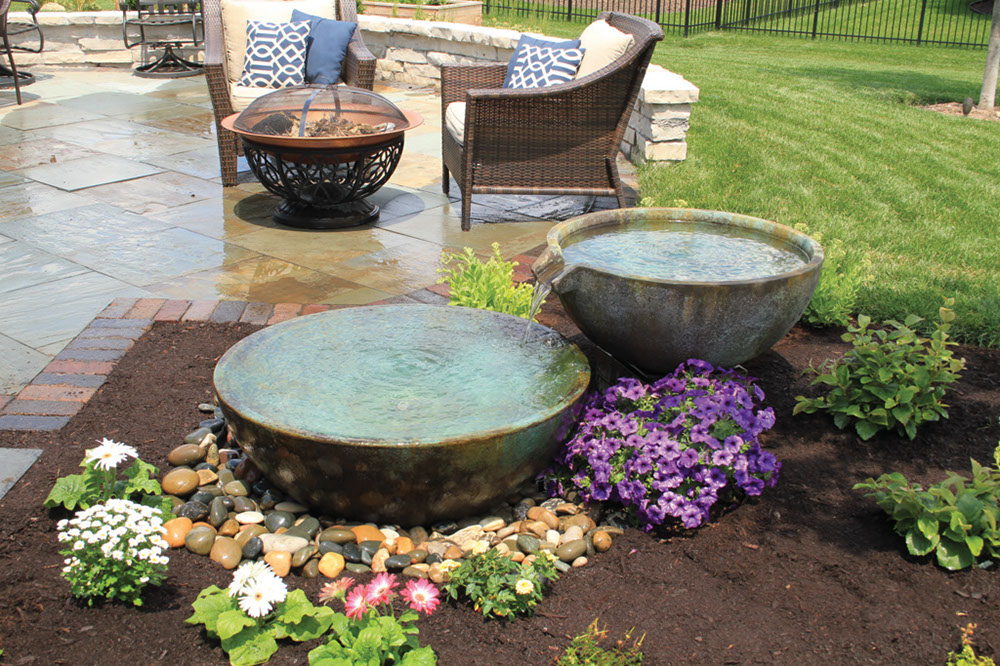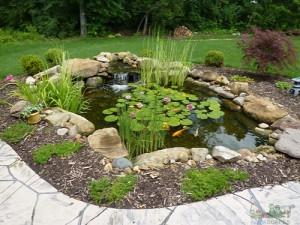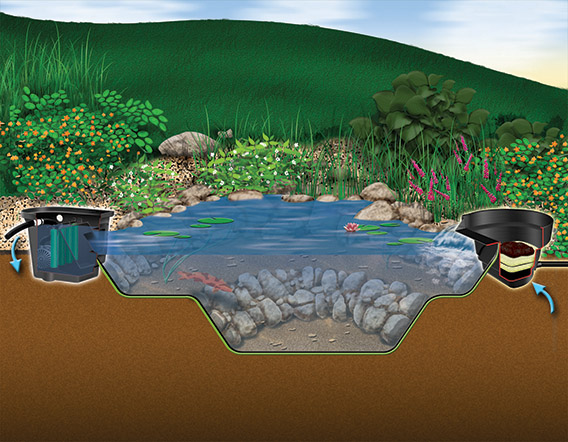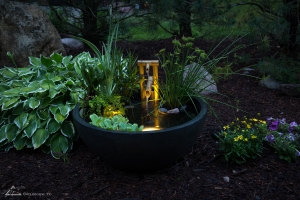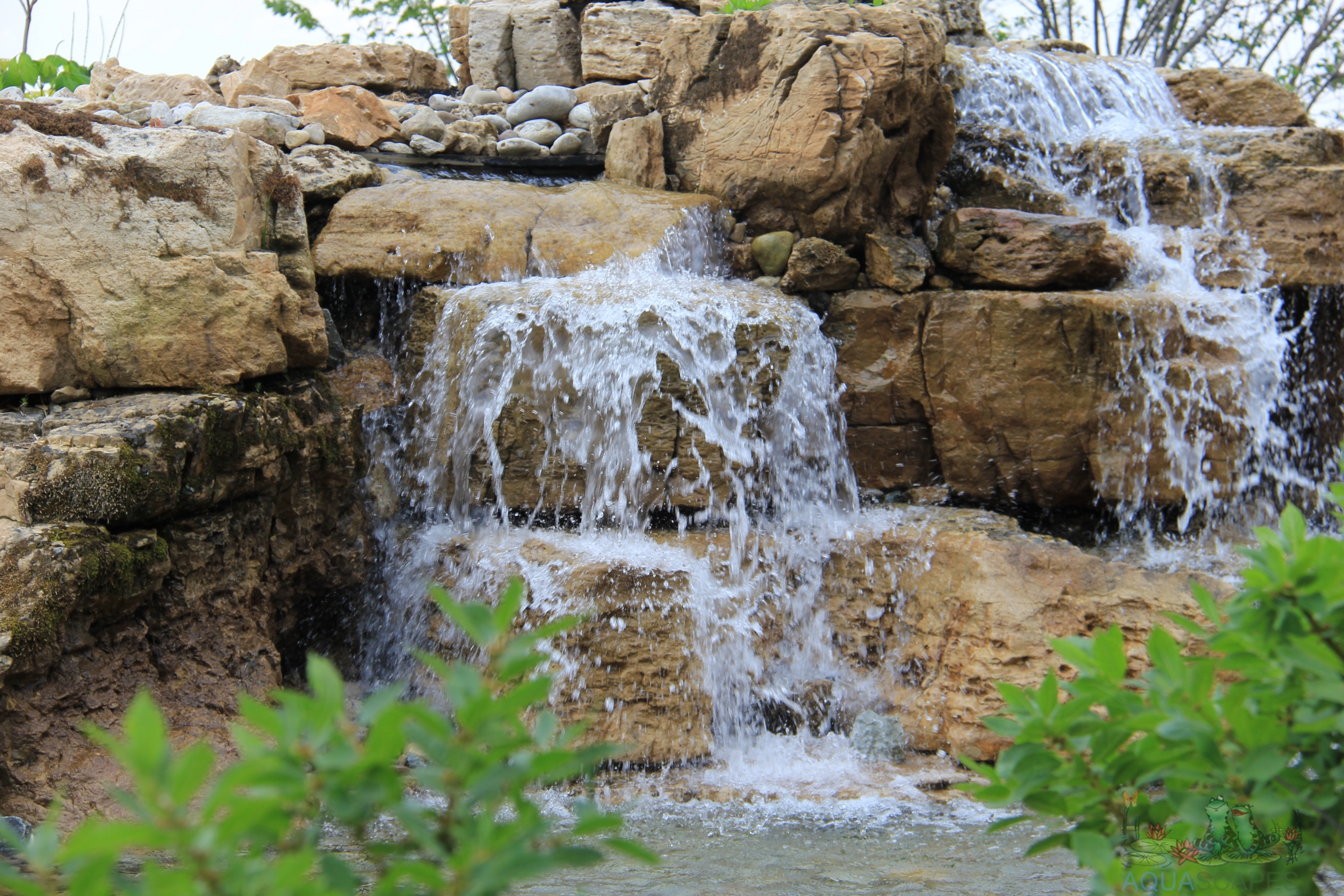All About Small Garden Ponds:
A Comprehensive Guide to Garden Ponds for Small Spaces.
Creating a small garden pond is a great way to add interest and beauty to your yard or garden. Not only will it provide a place for wildlife to visit and drink, but it can also act as a beautiful focal point in your landscape. But before you dig a hole and start filling it with water, there are a few things you should consider.
In this comprehensive guide, we’ll cover everything you need to know about small garden ponds, from choosing the right location to adding plants and fish. We’ll also share some expert tips on maintaining your pond so that it remains healthy and attractive for years to come.
So whether you’re just getting started with small garden ponds or you’re looking for ways to improve an existing pond, this guide will give you all the information you need. Let’s get started!
The first thing to consider when creating a small garden pond is the location.
You’ll want to choose a spot that gets plenty of sunlight, as many plants and fish need sunlight to thrive. You’ll also want to make sure the pond is close to a water source so you can easily fill it and top it off as needed.
Once you’ve chosen the perfect location, it’s time to start digging! The size of your pond will depend on the space you have available and what you plan to use it for. If you’re simply looking for a place for wildlife to visit, a small pond (between 2 and 4 feet wide) should suffice. But if you want to add plants and fish, you’ll need a larger pond (at least 6 feet wide).
Now that the whole has been dug for your small garden pond, it’s time to start lining it. You can use a variety of materials for this, including concrete, liner material, or even a plastic storage container. Whichever option you choose, be sure to properly seal and waterproof the pond so that water doesn’t leak out.
It’s time to fill your small garden pond with water. If you’re using tap water, be sure to let it sit for 24 hours so the chlorine can dissipate before adding any plants or fish. Once your pond is filled, you can add plants, rocks, and other decorations to make it your own.
Let’s talk fish!
If you want to add fish to your small garden pond, there are a few things to keep in mind. First, choose the right fish for your climate and pond size. Goldfish and koi are popular choices, but they require a larger pond (at least 3 feet deep) and can’t withstand cold winters. If you live in a colder climate, consider adding hardy fish like trout or catfish.
Second, don’t overcrowd your pond. A good rule of thumb is to start with one fish per 10 gallons of water. As your fish grow, you can add more.
Last, be sure to properly care for your fish. This includes feeding them quality food and keeping the pond water clean. A dirty pond can make your fish sick, so be sure to remove any debris or dead leaves on a regular basis. You should also perform a partial water change (about 10-15%) every few weeks to keep things fresh.
Guide to Aquascaping a Small Yard
There are two main types of small garden ponds:
Above-ground and Inground.
Above-ground ponds are easier for installation and maintenance, but they’re not as aesthetically pleasing as inground types; however, inground ponds require more work to install, but they offer a more natural look.
Above-ground Small Garden Ponds
Above-ground ponds are the simplest type of small garden pond to install. They’re also the most affordable option, making them a great choice for budget-minded homeowners.
The biggest advantage of above-ground ponds is that they can be installed almost anywhere. Whether you have a small patio or a large backyard, there’s likely a spot where an above-ground pond would fit perfectly.
Another advantage of above-ground ponds is that they’re easier to maintain than inground ponds. Since they’re not buried in the ground, you don’t have to worry about leaks or water seepage. And if you need to make repairs, it’s a lot easier to access an above-ground pond than an inground pond.
In-ground Small Garden Ponds
In-ground ponds are the most popular type of small garden pond. They offer a more natural look than above-ground ponds and can be customized to fit any space.
Installing an in-ground pond requires more work than installing an above-ground pond. But the extra effort is worth it if you’re looking for a high-quality pond. In-ground ponds also last longer than above-ground ponds, so you won’t have to replace them as often.
One of the biggest advantages of in-ground ponds is that they offer a more natural look. If you want your pond to blend in with your landscaping, an in-ground pond is the way to go.
In-ground ponds also offer more flexibility when it comes to size and shape. Whether you want a small, intimate pond or a large pond that’s big enough to swim in, an inground pond can be customized to fit your needs.
Things to Consider Before Building Your Small Garden Pond.
Building a small garden pond is a big project, so it’s important to do your research before you get started. Here are a few things to consider before you build your pond:
- Cost: How much money are you willing to spend on your pond? Ponds can range in price from a few hundred dollars to several thousand, depending on their size and features.
- Time: How much time are you willing to spend on maintenance? Ponds need to be cleaned and aerated regularly, so if you’re not willing to put in the time, you may want to reconsider.
- Location: Where will you build your pond? As we mentioned before, the location of your pond will determine its size, shape, and depth.
- Permits: Do you need any permits to build a pond on your property? In some areas, you may need a permit from the city or county before you can begin construction.
- Materials: What materials will you use to build your pond? There are a variety of options available, from concrete to liner kits.
Benefits of Having a Small Garden Pond
Ponds offer a variety of benefits, both for your home and for the environment. Here are just a few of the benefits of small garden ponds:
How to Choose the Perfect Small Garden Pond for Your Yard.
Now that you know all about small garden ponds, it’s time to choose the perfect one for your yard. Here are a few things to keep in mind as you shop:
- Size: As we mentioned before, the size of your pond will be determined by the size of your yard. If you have a small yard, you’ll want to choose a small pond.
- Shape: The shape of your pond is up to you. Some people prefer square or rectangular ponds, while others prefer more natural shapes.
- Depth: The depth of your pond will determine the type of plants and fish you can put in it. shallower ponds are better for plants, while deeper ponds are better for fish.
- Material: As we mentioned before, there are a variety of materials you can use to build your pond. Concrete is the most durable option, but liner kits are cheaper and easier to install.
Choosing the Right Location for Your Small Garden Ponds
When it comes to small garden ponds, location is everything. The spot you choose for your pond will determine its size, shape, and depth. It will also affect the type of plants and fish you can put in it.
So, how do you choose the right location for your small garden pond?
Start by considering the following factors:
Size:
How big do you want your pond to be? Keep in mind that ponds can range in size from a small potted plant to a large swimming pool. Once you’ve decided on a size, measure the area where you plan to put your pond to make sure it will fit.
Shape:
What shape do you want your pond to be? In-ground ponds can be any shape you want, but above-ground ponds are usually limited to circular or oval shapes.
Depth:
How deep do you want your pond to be? The depth of your pond will determine the type of plants and fish you can put in it. shallower ponds are better for plants, while deeper ponds are better for fish.
Sunlight:
How much sunlight does the location get? Ponds need at least six hours of sunlight per day to support plant life. If your pond will be in a shady spot, consider adding aquatic plants that don’t require as much sunlight.
Soil:
What type of soil is in the location? Sandy soil drains well and is easy to work with, but it doesn’t hold nutrients well. Clay soil holds nutrients well but doesn’t drain well. Loamy soil is a good mix of sand and clay and is the best type of soil for ponds.
Drainage:
Is the location well-drained? Poor drainage can cause waterlogged soil, which is not ideal for ponds. If the location you’ve chosen doesn’t have good drainage, consider installing a drain or raising the pond so it’s above the level of the surrounding ground.
Tips for Maintaining Your Small Garden Pond
Once you’ve built your small garden pond, it’s important to maintain it so that it stays clean and healthy. Here are a few tips for maintaining your pond:
-
Clean it regularly. You’ll need to remove debris from your pond on a regular basis. This can be done with a net or by hand.
-
Aerate it regularly. Ponds need to be aerated regularly to keep the water healthy. This can be done with an air pump or by adding a water fountain.
-
Test the water regularly. You’ll need to test the pH and ammonia levels in your pond on a regular basis. This can be done with test strips or a water testing kit.
-
Add plants and fish. Plants and fish help keep ponds clean and healthy. Choose plants that are native to your area, and don’t overstock your pond with fish.
How to Install a Small Garden Pond
Installing a small garden pond is a big project, but it’s definitely doable if you’re willing to put in the time and effort. Here’s a basic overview of how to install a small garden pond:
- Choose a location for your pond. As we mentioned before, the location of your pond will determine its size, shape, and depth.
- Excavate the area for your pond. This is a big job, so you may want to hire a professional excavator if you’re not comfortable doing it yourself.
- Install a liner. This will help prevent water from leaking out of your pond.
- Add plants and fish. Once your pond is complete, you can add plants and fish to it.
- Enjoy your new pond!
Basic Maintenance Schedule for Small Ponds
- Clean the pond once a week.
- Test the water once a week.
- Add plants and fish as needed.
- Aerate the pond once a month.
- Drain and clean the pond every year.
Weekly Cleaning: Remove debris from the pond with a net or by hand.
Water Testing: Test the pH and ammonia levels in your pond.
Aeration: Aerate the pond with an air pump or water fountain.
Annual Cleaning: Drain and clean the pond every year
Small Garden Ponds in Winter
Although small garden ponds are typically used as summer features, they can also be enjoyed in winter. If you live in an area that gets cold winters, you’ll need to take some steps to prepare your pond for the winter months. This includes adding a heater to keep the water from freezing and covering the pond with a tarp or blanket to insulate it.
The Beauty of Small Garden Ponds
Small garden ponds are a beautiful addition to any yard. They provide a place for plants and fish to thrive, and they add a touch of beauty and tranquility to your outdoor space. If you’re looking for a way to enhance your yard, consider adding a small pond. It’s a project that you’ll definitely enjoy for years to come!
Multiple Small Garden Ponds
You’re not limited to just one small garden pond. In fact, you can have multiple ponds in your yard. This can be a great way to create a beautiful and tranquil space. Just be sure to maintain each pond properly so that they stay clean and healthy.
Small Garden Ponds Accessories
There are a few things that you’ll need to get started with your small garden pond. Here’s a list of some of the most essential items:
- A liner: This will help prevent water from leaking out of your pond.
- A pump: This is used to aerate your pond and keep the water circulating.
- Test strips or a water testing kit: This is used to test the pH and ammonia levels in your pond.
- Plants: Plants help keep ponds clean and healthy. Choose plants that are native to your area.
- Fish: Fish help keep ponds clean and healthy. Don’t overstock your pond, though, as this can lead to problems.
Professional Installation of your Small Garden Pond or Do It Yourself?
If you’re not comfortable installing your small garden pond yourself, you can always hire a professional. This is usually a good idea if you’re not familiar with the process. Hiring a professional can also ensure that your pond is installed correctly.
What Kind of Small Garden Ponds Are Out There?
There are many different types of small garden ponds. Here are a few of the most popular:
- Preformed Ponds: These ponds come in a variety of shapes and sizes. They’re easy to install, but they’re not as customizable as other types of ponds.
- Rigid Liner Ponds: These ponds are made with a liner that’s held in place with rocks or bricks. They’re more customizable than preformed ponds, but they can be more difficult to install.
3 . Flexible Liner Ponds: These ponds are made with a flexible liner that’s held in place with soil or sand. They’re the most customizable type of pond, but they can be the most difficult to install.
Small Garden Pond FAQs
Question: Can small garden ponds be used in winter?
Answer: Yes, small garden ponds can be used in winter. However, you’ll need to take some steps to prepare your pond for the winter months. This includes adding a heater to keep the water from freezing and covering the pond with a tarp or blanket to insulate it.
Question: What kind of plants can I put in my small garden pond?
Answer: You can put any type of plant in your small garden pond that you want. However, it’s important to choose plants that are native to your area so that they’re able to survive in the conditions that you have.
Question: Can I put fish in my small garden pond?
Answer: Yes, you can put fish in your small garden pond. Fish help keep ponds clean and healthy. However, don’t overstock your pond, as this can lead to problems.
Question: Should I hire a professional to install my small garden pond?
Answer: If you’re not comfortable installing your small garden pond yourself, you can always hire a professional. This is usually a good idea if you’re not familiar with the process. Hiring a professional can also ensure that your pond is installed correctly.
Question: What are the different types of small garden ponds?
Answer: There are many different types of small garden ponds. The three most popular types are preformed ponds, rigid liner ponds, and flexible liner ponds. each has its own advantages and disadvantages. Choose the type that best suits your needs and preferences.
Question: What is the best way to Insulate my small garden pond for winter?
Answer: One way to insulate your small garden pond for winter is to cover it with a tarp or blanket. This will help to keep the pond from freezing over. You may also want to add a heater to keep the water warm.
Question: What’s the difference between a small and large garden pond?
Answer: The main difference between a small and large garden pond is the size. Small garden ponds are typically less than 10 feet in diameter, while large garden ponds can be up to 20 feet in diameter or more. Large garden ponds can be more difficult to install and maintain.
Question: How deep should my small garden pond be?
Answer: The depth of your small garden pond will depend on the type of plants and fish that you want to put in it. Generally, ponds should be at least 2 feet deep so that plants can root properly and fish can swim freely. However, if you’re only planning on putting small plants in your pond, a shallow depth may be sufficient.
Question: Do I need a filter for my small garden pond?
Answer: While filters are not required for small garden ponds, they can help to keep the water clean and clear. If you decide to add a filter to your pond, be sure to choose one that’s sized correctly for your pond.
Question: What is the best way to clean my small garden pond?
Answer: The best way to clean your small garden pond is to remove all of the plants and fish, empty the pond of water, and then scrub it with a hose and brush. You can also add a few inches of fresh water to the empty pond and let it sit for a few days before adding plants and fish back in.
Question: How often should I clean my small garden pond?
Answer: How often you need to clean your small garden pond will depend on the size of the pond, the number of plants and fish, and the conditions in your area. In general, ponds should be cleaned every one to two years.
Question: Can I put a small garden pond in my backyard?
Answer: Yes, you can put a small garden pond in your backyard. However, it’s important to choose a location that’s away from trees so that roots don’t damage the liner. You should also avoid placing your pond too close to your house so that water doesn’t leak into your basement or foundation.
Question: Are small garden ponds expensive?
Answer: The cost of a small garden pond will vary depending on the size, type, and features that you choose. In general, small garden ponds are less expensive than larger ponds. You can expect an entry price of at least $3000 for the smallest of water gardens.
Question: Should I add plants to my small garden pond?
Answer: Yes, adding plants to your small garden pond can help to create a more natural look. Plants also help to keep the water clean and clear by absorbing nutrients. Choose plants that are native to your area and that are appropriate for the size of your pond.
Question: What type of fish can I put in my small garden pond?
Answer: The type of fish that you can put in your small garden pond will depend on the size of the pond and the climate in your area. In general, goldfish and koi are good choices for small ponds. Be sure to check with your local wildlife department to find out which types of fish are legal to stock in your area.
Question: I don’t have much space. How do I utilize what I have?
Answer: One way to save space in your backyard is to install a small garden pond. While large ponds can take up a lot of room, small ponds can be just as beautiful and relaxing without taking up too much space. Here are a few tips for streamlining your small garden pond:
- Choose a location that’s out of the way so it doesn’t interfere with foot traffic or other activities in your backyard.
- If you have limited space, consider installing a raised pond so you don’t have to dig a hole.
- Don’t overcrowd your pond with too many plants or fish. A few well-placed plants and fish can make a big impact without taking up too much space.
Question: What if I don’t have enough room for a small water garden?
Answer: Water Features are a versatile addition to any backyard. If you don’t have room for a small garden pond, consider adding a fountain, waterfall, or other water feature. Water features can be installed in a variety of sizes and styles to fit your space and budget. These can be quite small if needed!
Question: Can I put the small water garden under my front steps?
Answer: Absolutely! This is common for many people who want to add a pond but are limited on space. Just be sure that the hole you dig is large enough to accommodate the size of your pond liner and that you have access to an electrical outlet so you can install a pump.
Question: I’m not very handy. Can I still install a small garden pond?
Answer: Yes, you can still install a small garden pond even if you’re not very handy. There are many preformed pond kits available that make it easy to get started. These kits come with everything you need to get started, including the liner, pump, and filtration system. You can also hire a professional to install your pond for you.
Question: What type of liner should I use for my small garden pond?
Answer: There are many different types of liner available for small garden ponds. The most common type of liner is a preformed liner, which is made from molded plastic. Preformed liners are easy to install and are available in a variety of shapes and sizes. If you’re looking for a more natural look, you can also use a flexible liner made from rubber or PVC. Flexible liners can be custom-fit to the shape of your pond and can be used to create ponds of any size or shape.
Question: How do I choose the right pump for my small garden pond?
Answer: The size of your pump will depend on the size of your pond. A good rule of thumb is to choose a pump that can circulate all the water in your pond once every two hours. Be sure to check the manufacturer’s recommendations to find the right size pump for your pond.
Question: What type of filter should I use for my small garden pond?
Answer: There are many different types of filters available for small garden ponds. The most common type of filter is a submersible filter, which is placed inside the pond. Submersible filters are easy to install and maintain and can be used with either preformed or flexible liners. If you’re looking for a more natural look, you can also use an external filter that’s placed outside the pond. External filters are less visible but require more maintenance than submersible filters.
Final Thoughts on Small Garden Ponds
Small garden ponds are a great way to enhance your outdoor space. They provide a place for plants and fish to thrive, and they add a touch of beauty and tranquility to your yard. If you’re thinking about adding a small pond to your yard, be sure to consider all of the above factors. With a little bit of planning, you can create a beautiful and tranquil space that you’ll enjoy for years to come!
Thanks for reading at Meyer Aquascapes! We hope you’ve enjoyed our post on garden pond design. Please leave a comment below if you liked it or have any questions. We’d love to hear from you! Thanks for stopping by!

